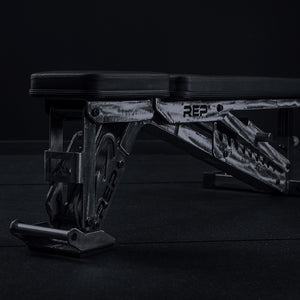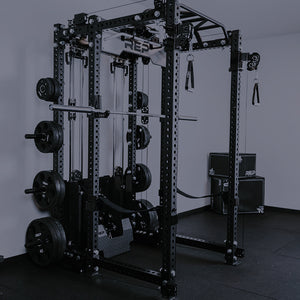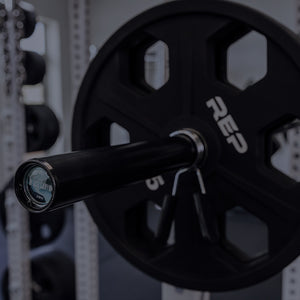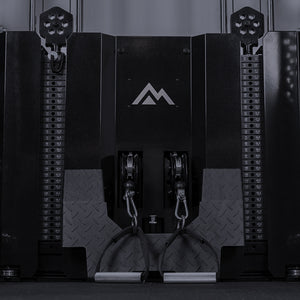
Press like a pro.
This article was reviewed by Ashley Boyer, ACE-CPT, for accuracy.
The Smith machine is an ideal tool for getting really really good at a lift you might otherwise use a barbell or freeweights for. If you're interested in mastering the shoulder press, we've got you covered.
Meet The Expert
Jake Dickson holds a B.S. degree in Exercise Science and is a NASM-CPT. As a health & wellness writer, Jake focuses on making fitness practical and accessible for any audience. Off the clock, you can find Jake at the gym or unwinding by the beach.
What Is the Smith Machine Shoulder Press?
The Smith machine catches a bad rap. As a personal trainer and strength coach for over a decade, it hurts to see—the Smith, which is basically a barbell fixed into a guiding rail system so it can only move up and down, is a fantastic training tool for beginners and veterans alike.
Take the shoulder press. Shoulder training isn’t as complicated as you might think; technique and proper form matter, but all you really need is one good pressing movement.
The Smith machine shoulder press is a good movement. In certain situations, I’d call it a great one. Here’s why, and how to do it right.
Smith Machine Shoulder Press: Muscles Worked
Let’s talk anatomy. Your shoulder, or deltoid, is composed of three major regions; the posterior, or back side, lateral deltoid, or middle, and anterior deltoid in the front.
The anterior deltoid is the power player for all overhead press variations, including the Smith machine overhead press. This muscle pulls your arm into flexion above your head. It’s one of several muscles that work together whenever you perform a shoulder press:
-
Your triceps extend your elbow in the second half of the exercise’s range of motion.
-
Your upper back, including the rear deltoid and smaller muscles around your rotator cuff, stabilize your shoulder blade as it moves.
-
Your abdominals and lower back help brace your spine against the resistance.
These muscles are all called into action to varying degrees when you press in the Smith machine, or with a barbell or dumbbell.
How to Perform the Smith Machine Shoulder Press: Step-by-Step
You’ll need to perform the Smith machine shoulder press sitting down due to height constraints. Grab an adjustable weight bench or low seat for this one.
-
Step 1: Put the bench or seat into the rack with the back support slightly behind the bar. The bar will need enough space to travel in front of your face.
-
Step 2: Rack the bar such that it is just below arm’s length overhead when you’re sitting.
-
Step 3: Sit down and reach up to grab the bar with a shoulder-width grip—adjust inward or outward as necessary for comfort.
-
Step 4: Twist the bar in your palms to unrack it and hold it overhead with your elbows locked.
-
Step 5: Inhale, tilt your head back slightly, and lower the bar down until it passes eye level, then push it back to the starting position.
Benefits of the Smith Machine Shoulder Press
Why am I a fan of the Smith machine? For all the reasons that separate it from the barbell. Let’s run through a few unique benefits to starting your shoulder workouts in the Smith machine:
It’s Beginner-Friendly
Starting your fitness journey is simple, but that doesn’t make it easy. One of the hardest parts to troubleshoot is finding exercises that are suitable for your body and skill level, while also effectively targeting major muscle groups.
The Smith machine shoulder press shines here. Overhead pressing is a fundamental human movement pattern, but learning to do so with the barbell can be intimidating. Pressing with the Smith is safer and will be more comfortable for most beginners.
Safe and Stable
Why is the Smith machine a perfect go-to for beginners? It’s safe and stable. Instead of the barbell floating freely in space, it’s fixed into a rail system which only allows it to move vertically.
Smith machines also have multiple safety mechanisms in place, such as a twistable bar that slides into catch hooks within the machine itself, or adjustable safety stops to prevent it from crashing down.
These factors make the Smith machine a go-fo for those taking their first steps in the gym.
They’re Everywhere
When it comes to the “where” of your fitness regimen, everyone falls someplace along the spectrum of home gym enthusiast to traveling gym junkie. For those who find themselves in new facilities regularly, the Smith machine shoulder press is invaluable.
Certain big box gyms, hotel fitness centers, even cruise ship gyms tend to have limited equipment options. However, you can find a Smith machine almost anywhere.
Accessibility makes the Smith machine shoulder press an invaluable tool to have in your toolbox if you don’t always know where your next workout is going to take place.
Smith Machine vs. Free Weight Shoulder Press
Here’s the good news: You can do overhead press variations with basically any type of equipment you can find in the gym.
The bad news? You can do overhead press variations with basically any type of equipment. The Smith machine and free weights both work wonders at building shoulder strength, but it’s where they differ that should matter to you.
Pros & Cons
Smith Machine: You can find one in most gyms, it’s generally safer for beginners, and provides ample stability.
However, the fixed range of motion might make it awkward for some people, and strength in the Smith machine doesn’t necessarily carry over to other implements.
Free Weight: You’ve got a lot of options, ranging from barbells to dumbbells and kettlebells, which allows you to customize the movement pattern to your body’s structure.
Conversely, free weights demand more shoulder stability and core strength, and performing these moves while standing also challenges your balance. Free weight overhead pressing might be a bit too demanding for beginners, elderly folks, or someone recovering from an injury.
Muscle Recruitment
When it comes to muscle recruitment, most people assume that activation is everything. It’s important, but there’s more to it—you can engage your glutes significantly during an unweighted hip bridge, but you won’t build much muscle if that’s all you’re doing.
Studies tell us that the Smith machine shoulder press may create better muscle activation than its free-weight counterparts. The authors of a 2020 study had this to say:
“This difference [in muscle recruitment] may be related to the type of equipment used (free weight vs. machine) where greater activation is observed in primary motor and stabilizer muscles … Thus, the use of the Smith machine in the [shoulder press] may have affected muscle activation by promoting greater stability during exercise execution.”
In plain English: The Smith machine stabilizes the bar for you, so supporting muscles don’t have to work as hard. With free weights, the challenge is dispersed across more of your body.
If you want to truly maximize muscle engagement in your shoulders for hypertrophy, the Smith machine is probably a better bet
Range of Motion
On the other hand, the inherent stability of the Smith machine’s design also makes it restrictive. The bar can only move up and down—your shoulders can move in just about any direction.
Some people experience pinching or discomfort when doing shoulder workouts with the Smith machine because it forces a specific range of motion.
If you’re able to work with free weights and find the Smith tedious to use, there’s no harm in skipping the Smith machine shoulder press. Barbells are the most stable free weights you can work with for strength training; dumbbells demand greater coordination, and kettlebells even more so.
Risk of Injury
No exercise is inherently injurious. Outside of rare catastrophic accidents, weight training injuries tend to occur when you put more tension on your tissues than they can tolerate, whether in a single session or across several weeks.
You can look at it like this:
-
If you’ve only ever done shoulder pressing in the Smith machine, trying to match the weight you use on a barbell, which demands more stability, might be risky.
-
If you like to do light overhead presses with dumbbells, and decide to test your 1-rep max strength in the Smith machine on a whim, you’re risking an injury.
Not because the Smith machine (or barbell, for that matter) is dangerous, but because it’s different.
Your takeaway: No matter what you like to use for your shoulder workouts, whether in a big box gym or a home gym, take it slow if the equipment necessitates a quality you don’t regularly train.
Progression
Progressive overload is the engine that powers all the changes you make in the weight room, whether you want to build muscle mass or increase your strength. Put simply, you need to gradually increase the challenge of the exercise in some way.
Whether that’s by increasing your range of motion, doing more reps, or slowing down your tempo is up to you. Some work better than others—for strength and muscle, adding weight to the bar is priority one.
The inherent stability of the Smith machine makes it simple and sustainable to add weight over time. However, because the Smith does some of the work for you, don’t expect to match your Smith overhead press strength with a barbell.
Conversely, barbells are famous for building robust and functional strength. The caveat is you have to do more than just push the thing over your head; you have to control it, and your body, as well.
As such, it can be difficult to add even small amounts of weight to your barbell press, forcing you to explore other options.
Common Mistakes to Avoid
On paper, overhead press variations like the Smith machine shoulder press are plain and simple. Push the thing over your head, that’s all there is to it!
But there’s a lot that can go wrong, even if you’re using the Smith machine. Keep these common errors in mind:
-
Don’t set the bar’s starting position at eye level. If you aren’t using the safety stops and the bar is too heavy, you won’t have a way to get out of the exercise.
-
Don’t lean your head back excessively and look at the ceiling. Tuck your chin to make room for the bar, but look mostly forward.
-
Don’t cut your range of motion short. If your flexibility allows, lower the bar down to just below your chin.
-
Don’t let your elbows drift back or forward at any time while pressing. Keep them directly under the bar.
-
Don’t arch your back excessively and turn the shoulder press into an incline bench press. It’s helpful to push your upper back into the seat slightly, but there’s a limit.
Variations & Modifications

If the Smith machine in your gym is broken—or you just don’t jive with the exercise, despite wanting the benefits—I’d recommend trying some of these variations instead. These moves and modifications keep the spirit of the exercise:
Incline Bench Press: You can bench in the Smith machine as well. Setting the bench to a 45-degree angle will stimulate your chest while hitting your shoulder muscles in a similar manner as the overhead press.
Floor Press: Do this one in the Smith machine, but you can use a barbell as well. By lying on the ground, you’re forced to limit your range of motion where your shoulders require the most flexibility.
Half-Kneeling Smith Machine Press: Take a knee instead of sitting on a bench or seat while you do your shoulder presses. This requires more coordination, but can help you build core strength and body awareness as well, and serves as a good transitional exercise if you want to eventually start using barbells instead.
Programming Tips
An exercise is only as good as how you use it. This goes for the Smith machine shoulder press (and all its variations). Here’s what you should do:
-
Intensity: There’s no need to max out on the Smith machine, but you can train to failure safely if you wish since the station prevents the bar from falling on you.
-
Sets & Reps: If this is your only shoulder press move, feel free to do up to 4-5 sets of 5-8 reps.
-
Frequency: Once a week is plenty, but consider adding a different press exercise to another workout later in the week.
-
Timing: You should start your workouts with compound exercises most of the time. Don’t save a shoulder press variation, even with the Smith, for the end.
Equipment & Setup Tips
Here’s your Smith machine shoulder press cheat sheet. Keep these tips in mind before your next set:
-
Check Bar Path: Some Smith machines have fixed bars that move up at a slight angle. You can face whichever direction you want for most exercises, but for overhead pressing, make sure the bar moves up and back behind your head. Don’t press up and away.
-
Use the Bar: Rack the Smith bar below waist level so you can use it to help align the bench or seat properly. You can check visually with the bar itself or the knurling.
-
Set Up Safeties: All Smith machines have adjustable safety stops. Set them up slightly below the bottom of your intended range of motion.
-
Plant Your Feet: Keep your feet on the ground and push against the floor gently while performing the overhead press.
FAQs
Is the Smith machine shoulder press effective?
Absolutely. It’s one of the best exercises you can perform in the Smith machine for strength or muscle, due to the comfort and stability provided by the station itself.
Is the shoulder press bad for your shoulders?
Not necessarily, but some people may find it uncomfortable. The Smith machine’s bar moves on a fixed path, which may not be compatible with your unique anatomy. In such cases, you’ll have to tweak your grip width, bench angle, or find a substitution exercise instead.
Should I use the Smith machine if I’m new to pressing?
Yes! The Smith machine is one of the best beginner shoulder exercises out there, since it drastically limits the risks of dropping the weight.
This article was reviewed by Ashley Boyer, ACE-CPT, for accuracy.
References
1. Campos YAC, Vianna JM, Guimarães MP, Oliveira JLD, Hernández-Mosqueira C, da Silva SF, Marchetti PH. Different Shoulder Exercises Affect the Activation of Deltoid Portions in Resistance-Trained Individuals. J Hum Kinet. 2020 Oct 31;75:5-14. doi: 10.2478/hukin-2020-0033. PMID: 33312291; PMCID: PMC7706677.
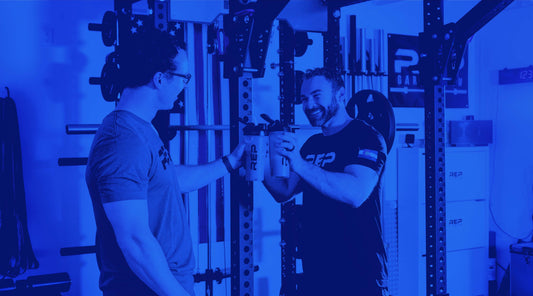
NEWSLETTER SIGNUP
Product launch information, promotions, blogs, and REP news.

